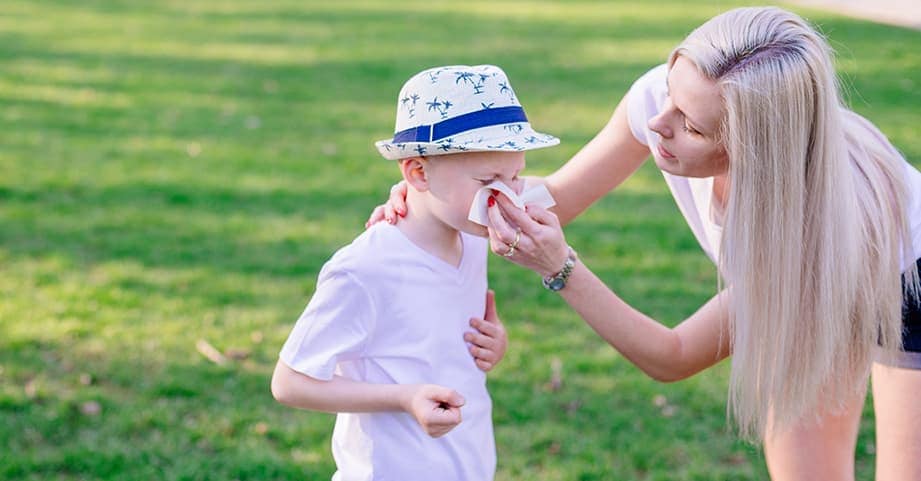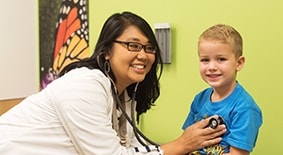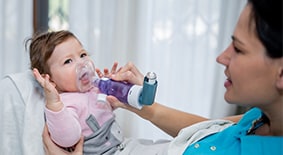Taking Control of Seasonal Allergies
Updated 4/5/21
Does your child have the sniffles? There are ways to tell if they are symptoms of allergies in kids. Here’s what to look for and practical tips for managing childhood allergies.
If your child gets a runny nose, itchy eyes and tickly throat in certain times of year, they’re likely suffering from seasonal allergies, often called hay fever. One symptom not typically associated with hay fever is an actual fever, so if your child runs a fever, that probably means it’s something else.
“Children suffering from springtime allergies tend to be more itchy and sneezy than when they are sick with a fever from an infection,” says Tricia Lee, MD, a pediatric allergist and immunologist. “Generally allergy symptoms also persist throughout a season over weeks as opposed to an infection like a cold which can resolve in a few days.”

What causes allergies in kids?
Allergies occur when an overactive immune system goes into action against normally harmless substances like pollen from grasses, weeds and trees. Allergies often start in childhood and continue into adulthood. Fortunately, certain therapies can help control some symptoms, and most can be managed and controlled with help from your child’s pediatrician. If symptoms become hard to manage despite common allergy treatments, then an allergist may consider allergy testing and if positive, allergy shots can help train the immune system to be less reactive.
One way to tell if your child is suffering from seasonal allergies is if chronic cold-like symptoms return around the same time each year and last more than a week or two.
Is it a cold, an allergy or asthma?
For some children, they’re at their worst in the spring when trees are pollinating; for others, it’s in the fall when grasses are pollinating.
Common allergy symptoms in kids include:
- Runny nose
- Sniffling
- Sneezing
- Wheezing
- Watery, itchy eyes
- Itchy ears and throat
- Thin, clear nasal drainage that persists
Some less common symptoms include:
- Patches of bumps or itchy, red skin that won’t go away
- Hives (itchy skin eruptions that usually last for a few hours and may move to different parts of the body)
- Headache
- Fatigue
- Nausea
If your child is wheezing or having breathing difficulty that seems to be triggered by allergies or other factors such as exercise, cold air or air pollution, it may also be asthma, a chronic disease that starts in the lungs. It’s a different condition than allergies (although many people with asthma also suffer from environmental allergies).
If you suspect your child might have asthma, make an appointment with your pediatrician as soon as possible. Asthma is manageable, but can be serious if left untreated.
How can I help manage my child’s allergy symptoms?
If your child is showing allergy symptoms, try to reduce their exposure to pollen and mold with some of these pediatrician-approved tips:
- After coming inside from playing outside, have your child bathe their hair and body, then change into fresh, clean clothing. This will keep pollen off hair, skin and bedding.
- Keep windows and outside doors shut during pollen seasons, and run air conditioning on low to continually clean the air in the home.
- Don’t let your child play in moist outdoor areas, where mold can grow.
- Your child should stay indoors when grass is being mowed and avoid playing in fields of tall grass. If they do go outside in the morning or on windy days, they should wear a mask.
- Be aware that dogs and cats can also bring pollen and mold indoors. You may want to wipe pets down with damp towels or paper towels when they come in from being outside.
- Follow pollen counts. On days when they are very elevated, consider indoor activities or choose to go outdoors later in the day after the pollen counts have peaked.
- Wear a billed hat and glasses to minimize exposure to pollen in the eyes.
What medicine should I give my child for allergies?
Your child may need medication to control allergy symptoms, so start with your pediatrician, who may prescribe antihistamines, and/or nasal corticosteroids. Your doctor may also refer you to a pediatric allergy specialist, who may recommend allergy testing and, if positive, consider immunotherapy (allergy shots) to reduce allergy symptoms and decrease the need for daily medication.
How can I help prevent allergy and asthma symptoms for my child?
The great outdoors isn’t the only place where your child may be exposed to allergens. Even your own home can have plenty of allergy triggers.
Keep an eye out for these at-home allergens:
- Dust mites are microscopic organisms found in bedding, upholstered furniture and carpet. These can be stirred up in spring and fall when you switch from heat to air conditioning (or vice versa), so be sure to have ducts cleaned at least every three years.
- Furry animals (cats, dogs, guinea pigs, gerbils, rabbits, etc.).
- Pests, such as cockroaches and mice.
- Molds and fungi.
What are some cleaning tips to help with my child’s allergies and asthma?
- Dust mites are the most common trigger of asthma and allergy symptoms inside the home. As their name suggests, they thrive on dust, so dusting is recommended.
- Dust furniture and surfaces with a nontoxic cleaner.
- Use a damp rag or duster to wipe blinds and picture frames clean.
- Remove window treatments, since they tend to collect dust, and wash or dry-clean them.
- After dusting furniture, blinds and other surfaces—use a damp mop on wood floors and a vacuum cleaner with a HEPA filter on carpets to collect any remaining dust that has fallen.
- The greatest exposure to dust is actually in bedding. Clean and protect bedding and play areas in bedrooms.
- Cover mattresses, box springs, pillows and cushions in allergen-proof zip-top covers (available through catalogs and specialized retailers).
- Wash bedding in hot, soapy water once a week.
- Store toys, games and stuffed animals in plastic bins with covers. Wash stuffed animals if able. If unable, put in plastic bag to freeze over night. Extreme temperatures both really hot and really cold help kill dust mites.
- Fight mold and mildew in damp areas.
- Remove moisture in the air with a dehumidifier (clean the fluid reservoir after use to prevent mold growth) or fans. Open windows if possible.
- If you have mold or mildew on walls or floors, clean using these recommendations by the American Academy of Allergy, Asthma & Immunology:
- Mix 2 cups of vinegar with 2 cups of very hot water, ½ cup of salt and 2 cups of borax. Apply solution to walls and let sit for 30 minutes. Then apply solution again, scrubbing with a soft bristled brush. Rinse well with plain water.
- Once area has been fully cleared of any growth, spray full-strength vinegar on the walls to help prevent new mold/mildew from growing. Don't rinse, just air dry.
Contact Us 404-785-KIDS (5437)


